Last updated on October 5, 2023

Gingerbread Hunter | Illustration by Milivoj Ceran
Greetings planeswalkers! Wilds of Eldraine has been draftable for about a month now, and Worlds/the Vegas Limited Open just wrapped up. It’s time to figure out what we’ve learned so far so that the rest of the season (Store Championships, Sealed RCQs, the second Arena Open in October, and plain old online/Arena drafts) goes swimmingly!
This guide builds off the material covered in my WOE Sealed article and should tell you everything you need to know for success in the wilds. We’ll cover commons, color pairings, and trophy examples for your learning!
Let’s jump into it!
Format Big Picture
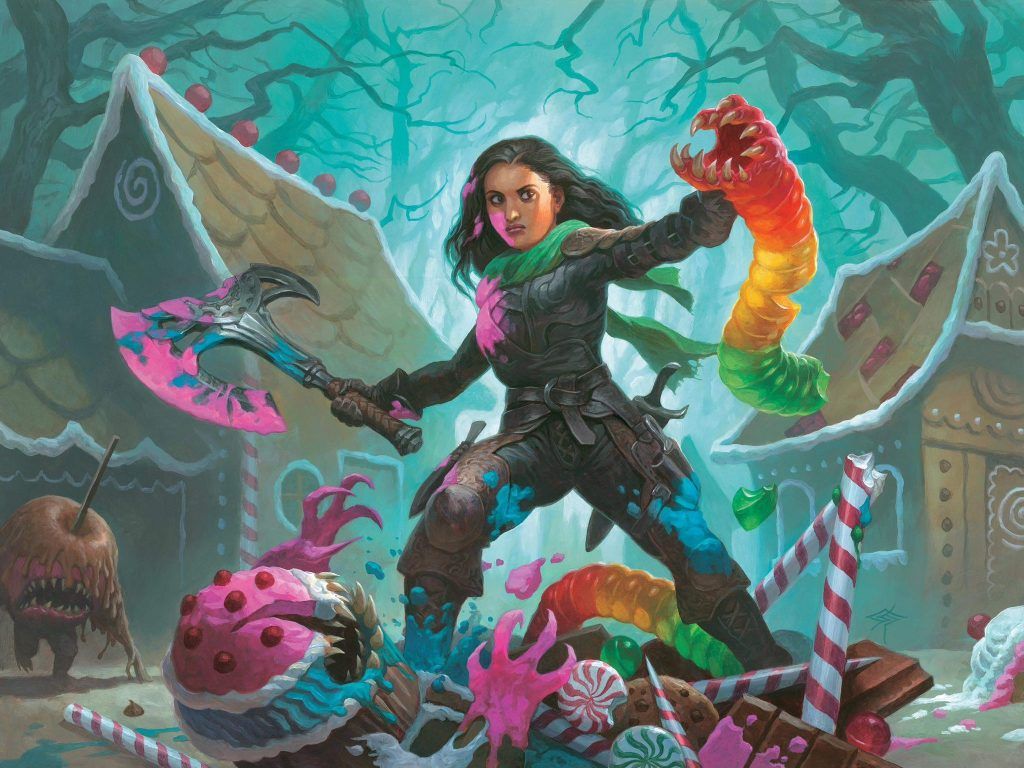
Greta, Sweettooth Scourge | Illustration by Steve Prescott
Wilds of Eldraine is a fast but balanced format with several viable playstyles and decks. Rx aggro seemed like the clear thing to be doing Week 1, but then Golgari Food emerged as a decent counter to it. Food can struggle a bit with Ux Control in turn, as the Cursed role tokens and countermagic are strong against Hamlet Glutton. And as you might have guessed, Ux control is unfavored against Rx aggro. None of these matchups are that lopsided (6:4 at worst), but it’s a neat way to think about Wilds of Eldraine.
Aggro
The format’s aggro decks are Boros Aggro, Rakdos Rats, and Gruul Monsters. All of these archetypes are strong and play out a bit differently. They all prey on ramp/blue strategies and help to keep everyone else honest with how much greed they can get away with.
Midrange
The format’s midrange decks are Golgari Food, Selesnya Roles, and Orzhov Midrange. Golgari Food is my pick for the best archetype in the format (more on that later). Expect these decks to straddle the line between aggression/control, as midrange often does.
Control
The format’s control decks are Dimir Faeries, Izzet Spells, and Simic Ramp. These color pairs will be interested in playing the long game most of the time. Faeries is probably the most aggressive of the bunch, and might be better described as a “tempo deck” depending on your build.
What About UW?
Azorius Frost is a pretty bad archetype that sits somewhere in the middle of Aggro/Midrange in terms of its pace. I’ll still be covering it in more detail below.
Color Balance
In terms of overall color balance, I’d rank the individual colors in Wilds of Eldraine as follows:
- Red
- Black
- Green
- White
- Blue
Red has great removal, efficient creatures, and can even splash bombs with three common Treasure-makers, all of which are decent. Black has the best common (Candy Grapple) in the set, solid curve filler, and good setup for bargains. Green has several viable ramp/fixing spells and strong fatties, but it lacks removal. White has the sweetest combat trick (Archon's Glory) and some good cheap creatures. And finally, blue has the strongest card draw spells but struggles to create space to use them on its own.
Top Commons
This is a sequel to my Sealed article's guess at the best commons in each color. With 17lands GIH win rates as a benchmark, how did my predictions fair?
White
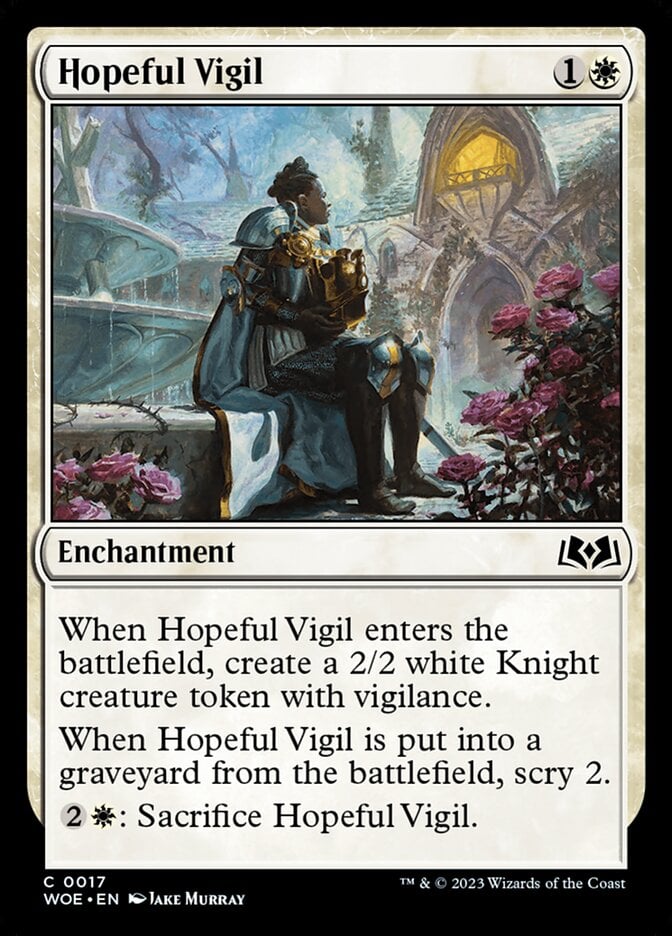
Hopeful Vigil: Called this as #2. Turns out it’s even better than I expected. Bargain is obviously a big draw, but Hopeful Vigil is a premium 2-drop in white even without it.
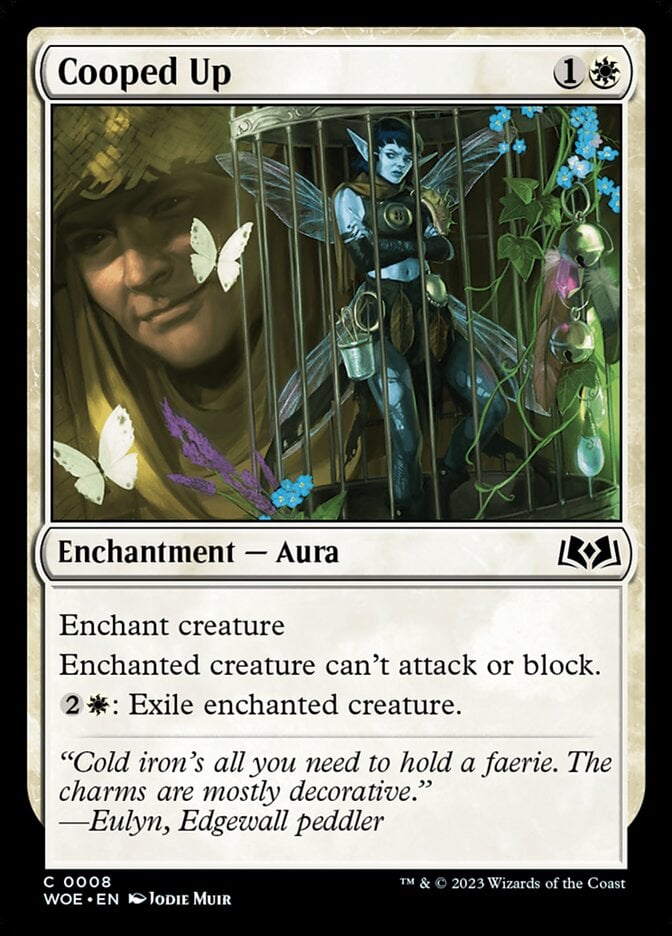
Cooped Up: Had this as #1. It’s a strong removal spell with light aura/bargain/”enchantment goes to the graveyard” synergies. Cards like Stormkeld Vanguard are threatening, but the set only has a handful of them.

Archon's Glory: Had this as #4. This is just an amazing trick that’s even easier to bargain than I had expected.

Stockpiling Celebrant: This card has played out better in practice than I had hoped. Use it with cards like Hopeful Vigil, Hopeless Nightmare, Prophetic Prism, and The Princess Takes Flight!

Kellan's Lightblades: It’s a solid removal spell that excels in more controlling white decks, but I’m happy to play the first copy anywhere. The bargain mode is important for giving white another answer to Hamlet Glutton.
My score: 3/5
Rimefur Reindeer and Frostbridge Guard were my whiffs for white. Neither is unplayable, but they both ended up being mediocre curve filler cards thanks to Azorius’s general failure as an archetype.
Blue
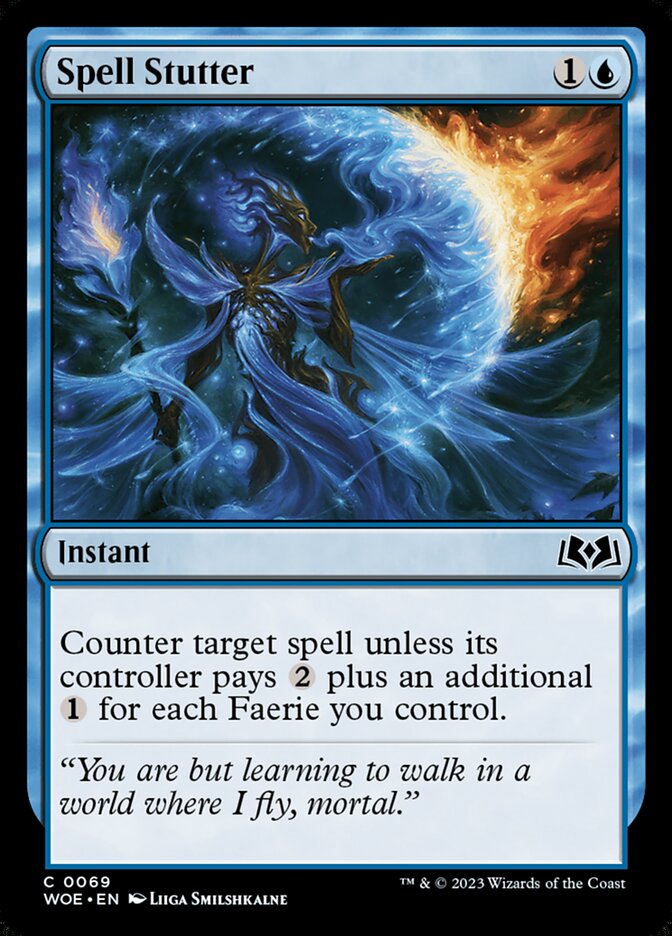
Spell Stutter: Had this as #3. Getting on board early in Wilds is important, so this ended up being a great Quench format. The extra Faerie synergy is nice but hardly necessary.
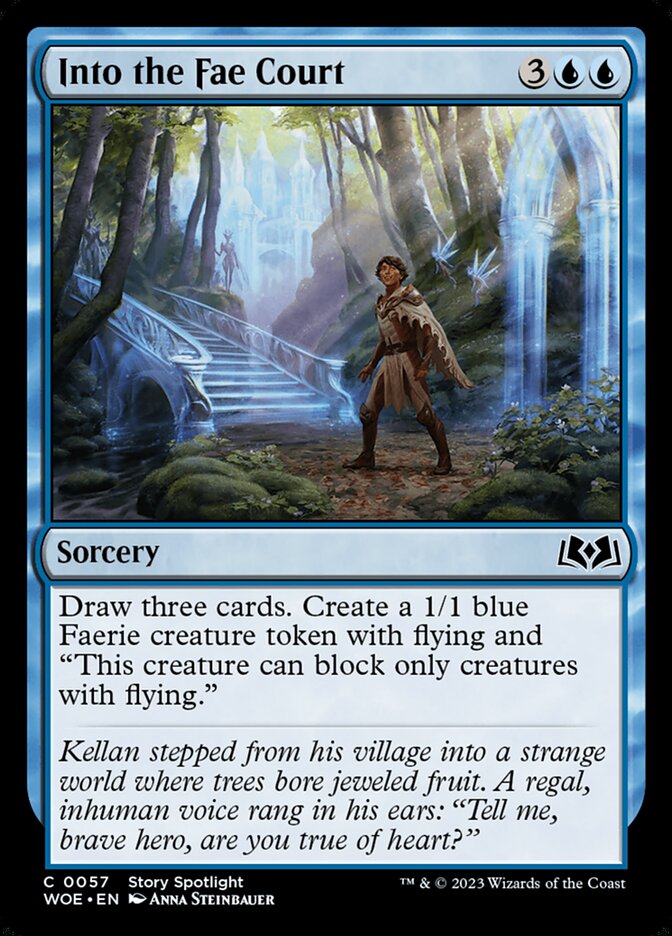
Into the Fae Court: This is one of the highest “oomphf” commons as it puts you up two cards + a small flier (which you can even bargain with). It’s slow, but you can compensate for that by building a lean deck otherwise. Best in Izzet or Dimir , as Simic might want to play 5-mana spells that affect the board more.
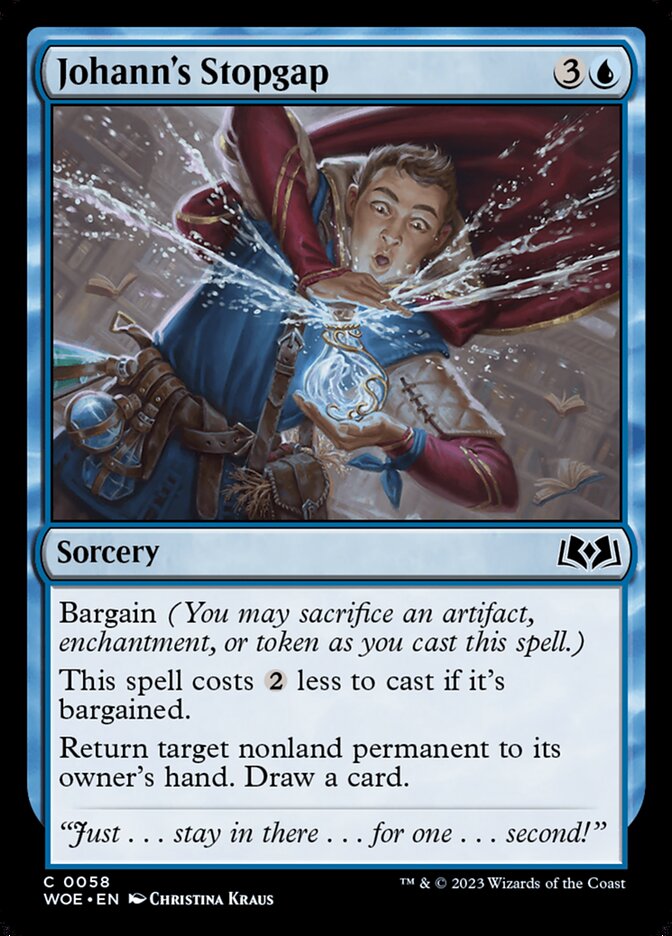
Johann's Stopgap: This is a decent card due to how practical bargain has played out. The Hatching Plans dream is also real and one of the better reasons to be blue in this set.
Sleight of Hand: The success of this card suggests the success of Izzet as an archetype. It’s also a fine filler card even without spells payoffs.
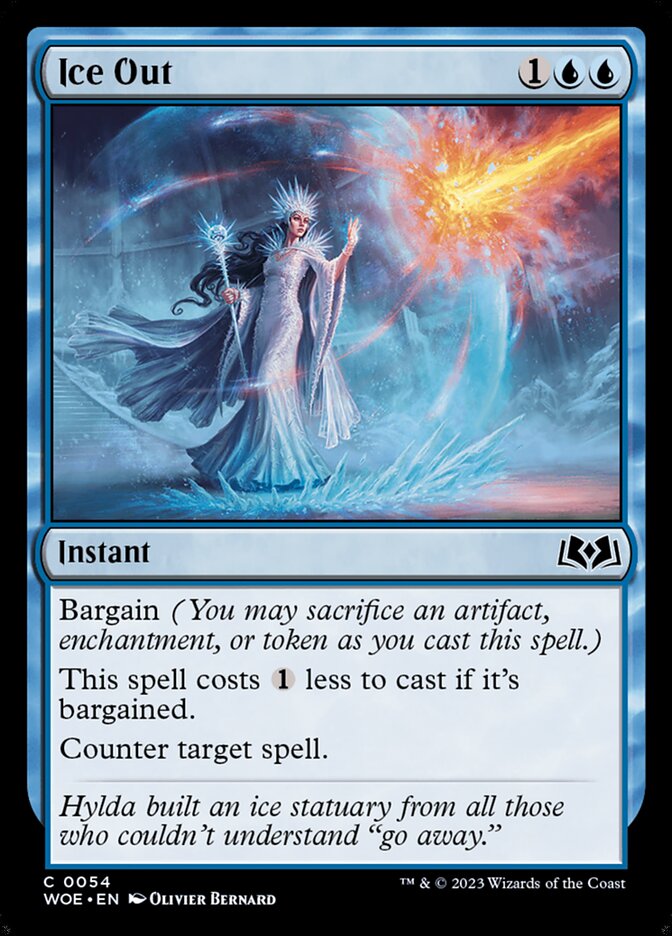
Ice Out: Once again we see another bargain card overperforming. Countermagic also does well against adventures and bargain spells, as adventures are telegraphed and bargain will still require your opponent to sacrifice whatever they offered.
My score: 1/5
I overrated blue’s common adventures and Quick Study. None of these cards are horrible, but they don’t do a great job of contesting the board early against most creatures. Cursed tokens are also pretty inconsistent in how useful they are, and can feel like bargain fodder in non-green matchups.
Black

Candy Grapple: No brainer. Calling this as #1 was as easy as similar cards like Fire Prophecy, Contagious Vorrac, etc.
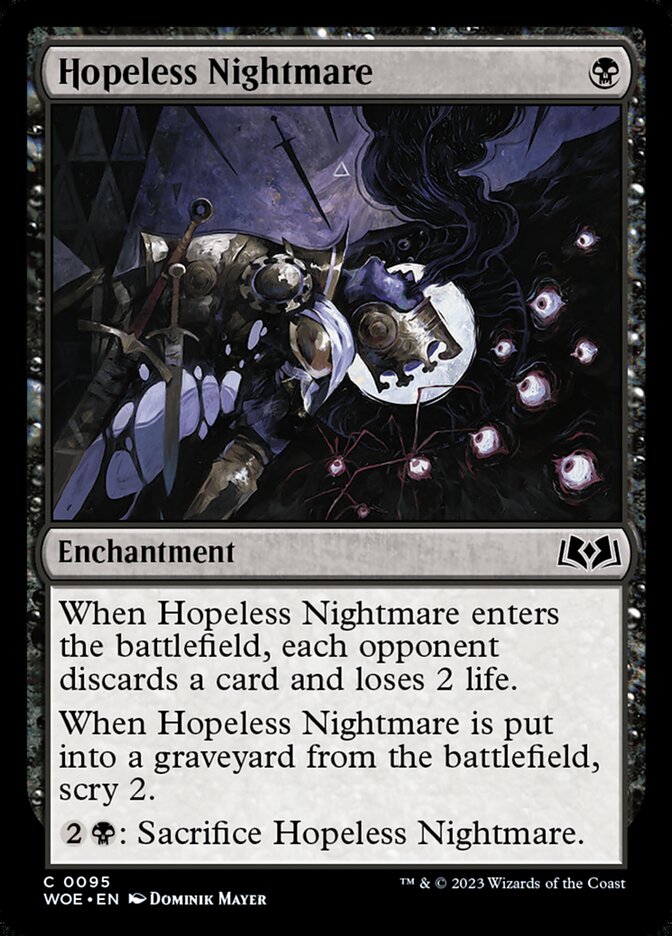
Hopeless Nightmare: Turns out bargain + bargain enablers is where you want to be in this set! The base rate here is fine, but it’s obviously the easy synergies that make it so good.
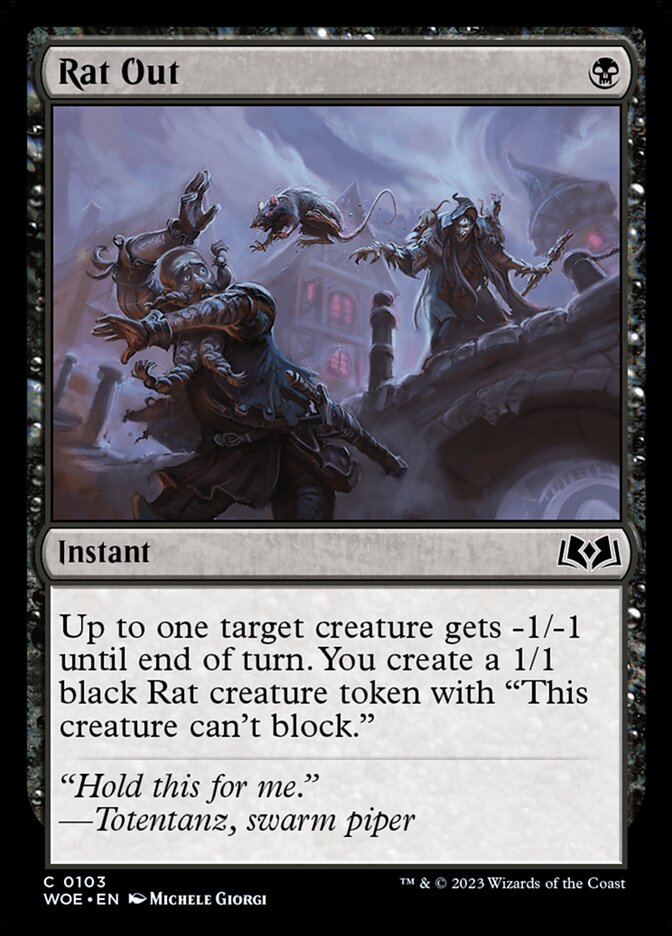
Rat Out: Killing x/1s or winning clutch combats while making bargain fuel is nice. I’m personally less high on this card than its stats say I should bet, but the first copy is good.
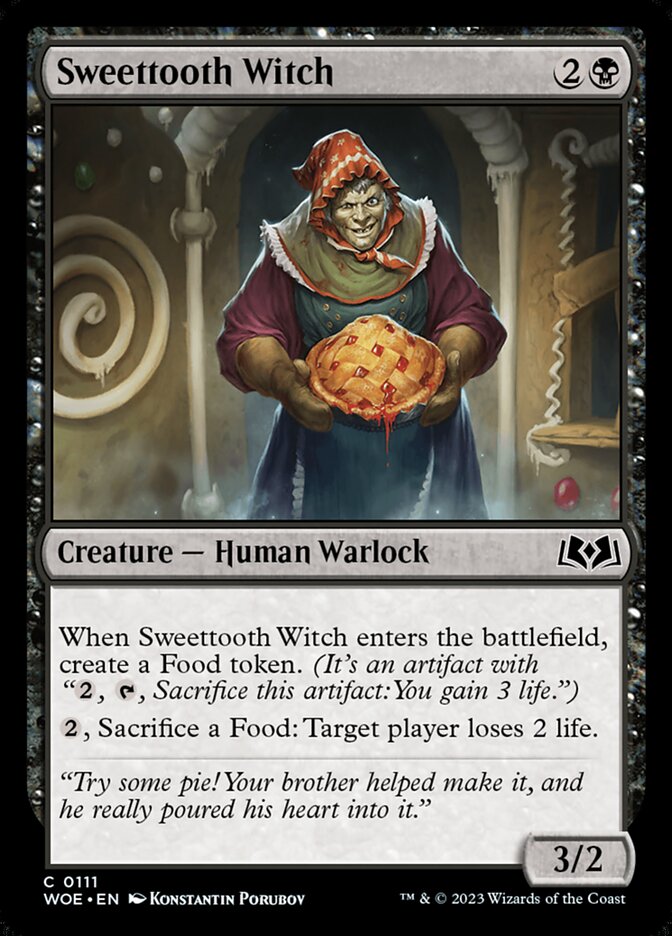
Sweettooth Witch: Black’s best common creature is a decent value creature that can burn your opponent out late game. Solid everywhere but excellent in Golgari Food.
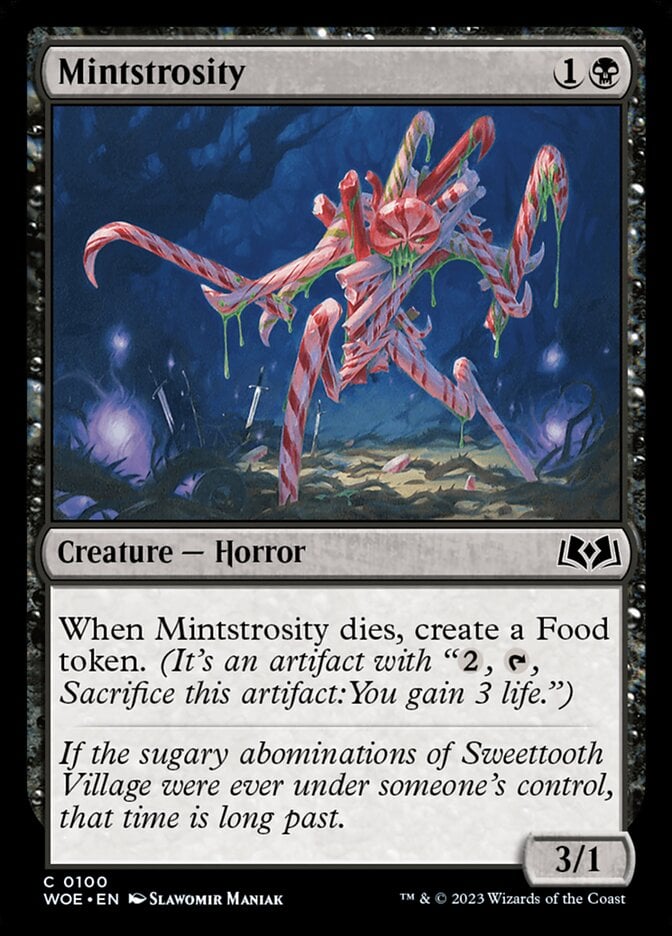
Mintstrosity: This is a great all-purpose 2-drop that trades well with other cheap creatures. It does trades down with Flick a Coin and Rat Out though.
My score: 1/5
Once again, I rated cards that feel like filler (Fell Horseman and Stingblade Assassin) too highly. Stingblade Assassin is a nice rate but suffers from the format lacking many fatties, and the 1 toughness can be a liability. Fell Horseman is fine but a bit slow. Barrow Naughty and Feed the Cauldron barely missed the top 5, so I’d still recommend those!
Red
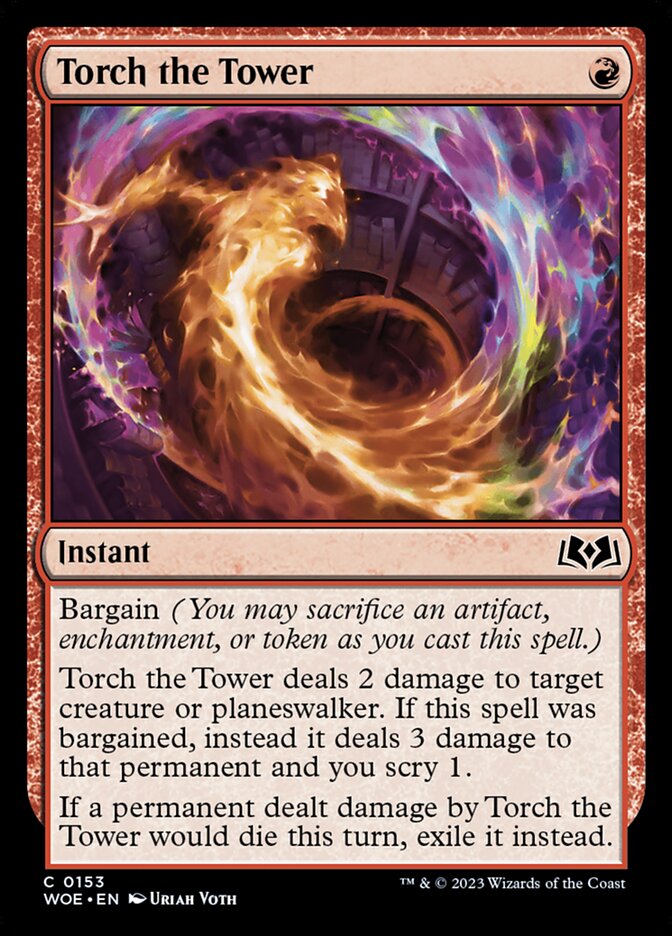
Torch the Tower: Another easy call, though this was closer in power level to Candy Grapple than expected. Creatures are small, bargains are easy, and the exile is relevant too.
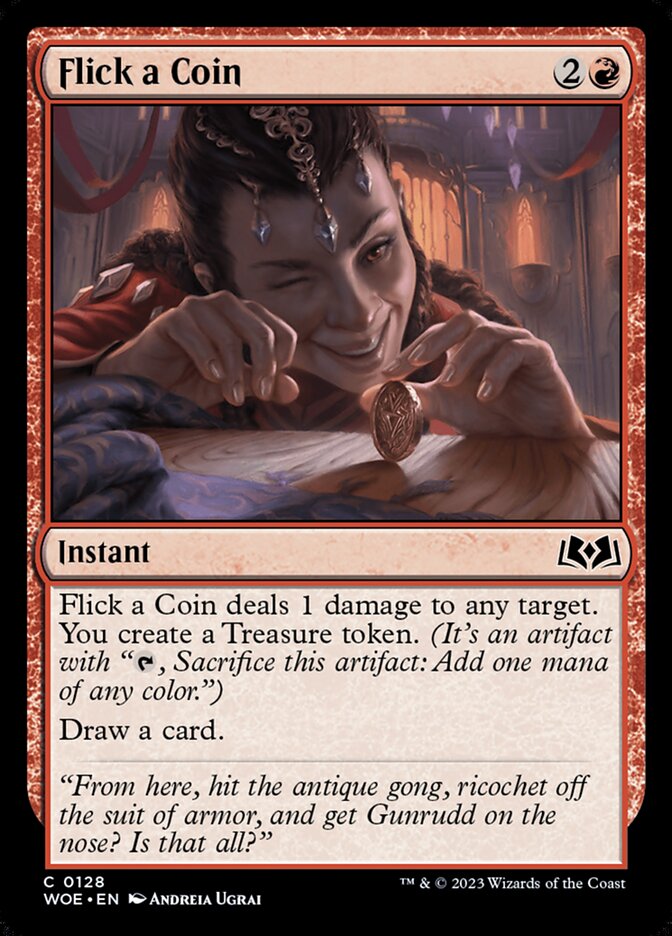
Flick a Coin: Strong cantrip that is playable in any red deck. Particularly excels in Izzet Spells.
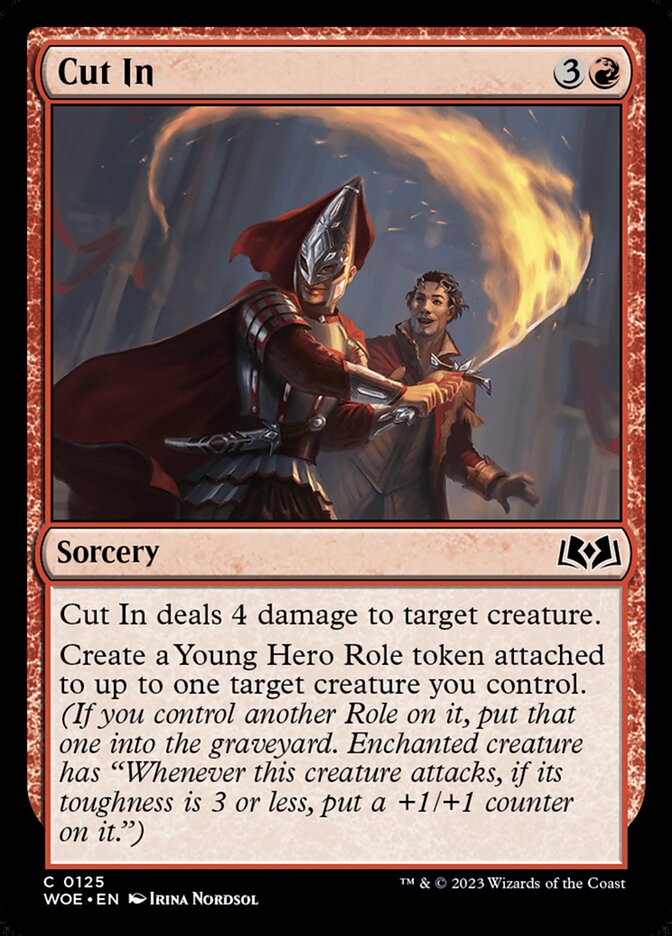
Cut In: Young Hero is the strongest of the six roles, so it turns out that getting one for free on a kill spell is really good!

Edgewall Pack: It’s a doggo with great stats: definitely the curve topper I’d want for my Boros /Rakdos decks as it checks rat/celebration boxes and keeps the pressure on.
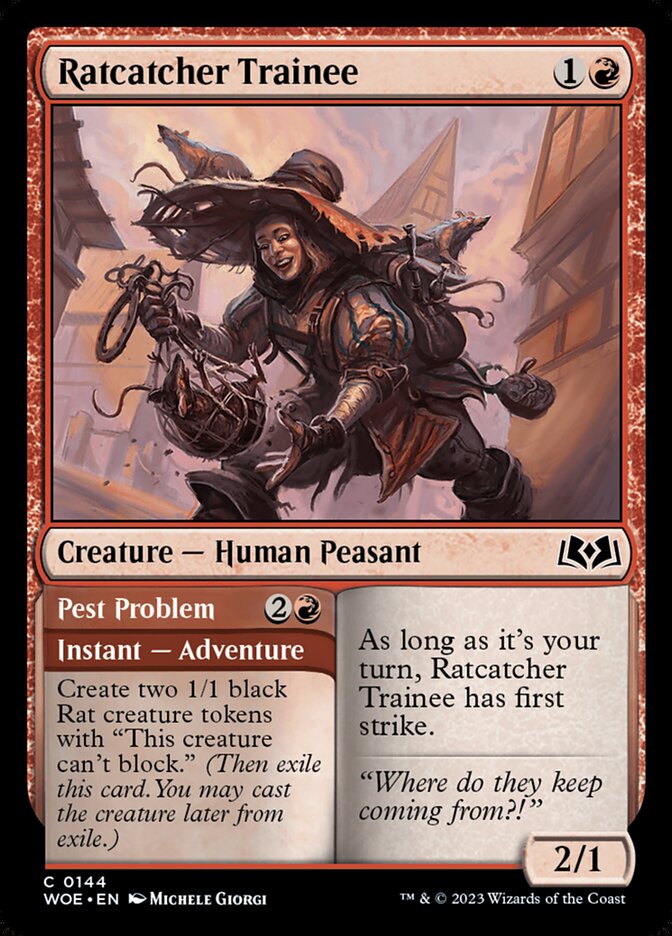
Ratcatcher Trainee: Had this as #3. It’s decent rate on turn 2 and also triggers celebration/goes wide if you have another play that turn.
My score: 2/5
Grand Ball Guest and Minecart Daredevil have been solid roleplayers in aggro. Grabby Giant is great in some bigger red decks, but it’s easily outclassed by Edgewall Pack in most.
Green
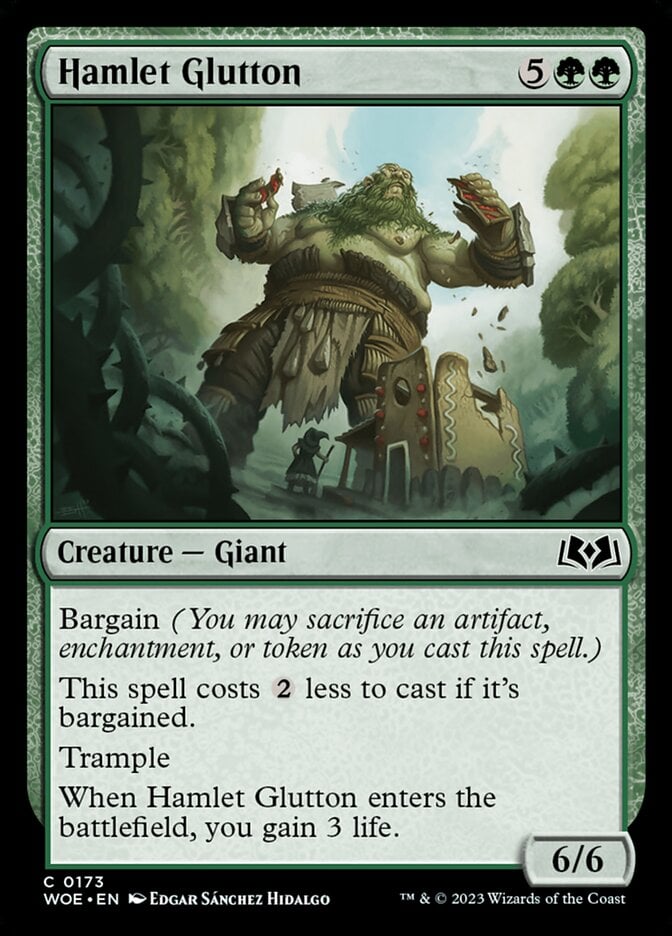
Hamlet Glutton: Almost called this one (had them at#2)! This body-positive monster is one of the most important commons in the set, and it can be a good signal for green being open.
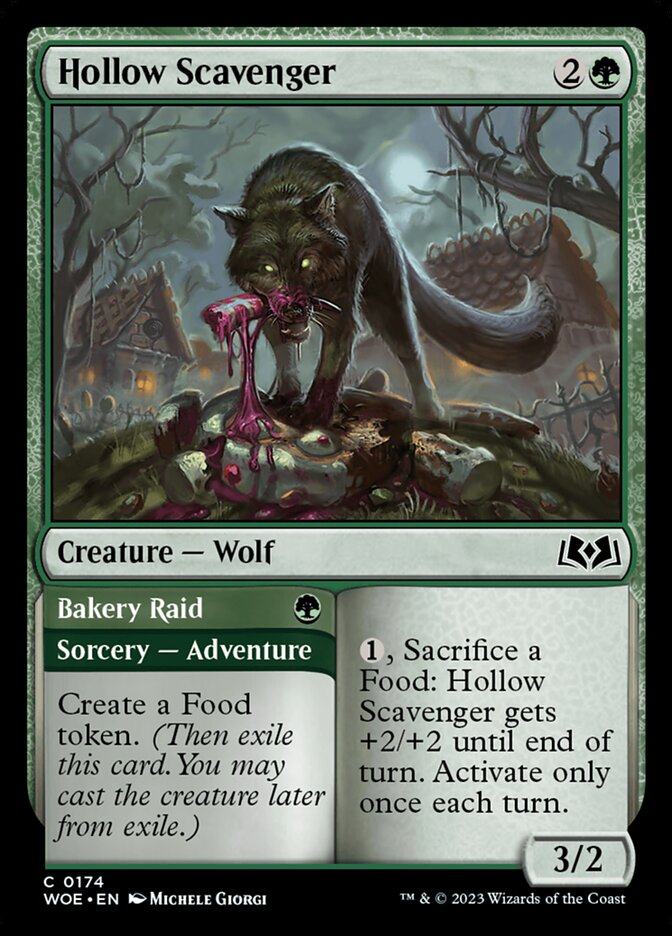
Hollow Scavenger: Solid value creature that plays a bit like Sweettooth Witch. It’s better in combat, though, and great in every Gx archetype.
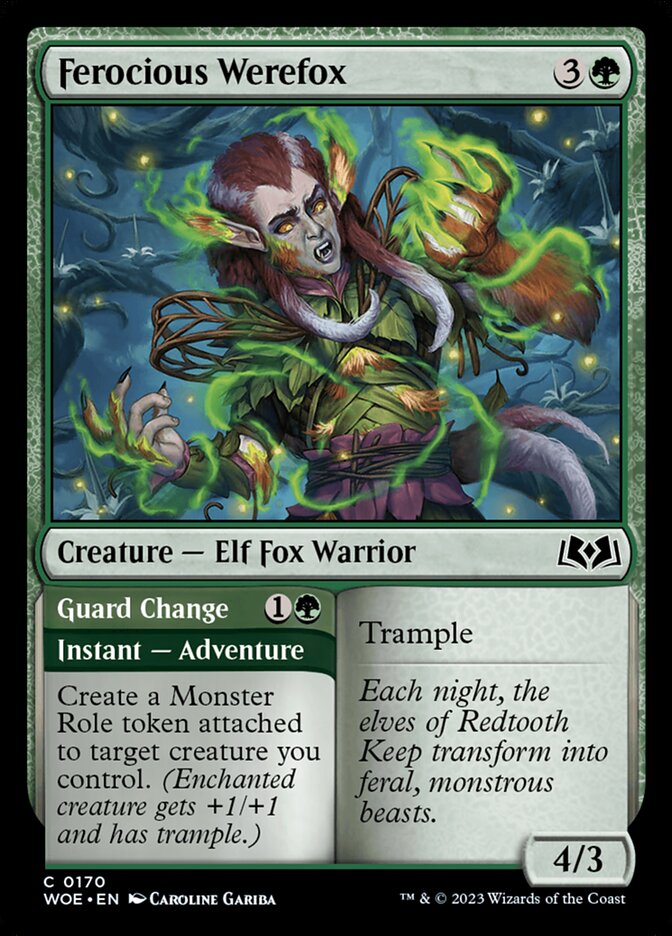
Ferocious Werefox: Underrated this one a bit as the format is both smaller and faster than expected. 4/3 Trample will often be the largest thing on board, and the extra bargain/enchantment synergy from Guard Change matters often.
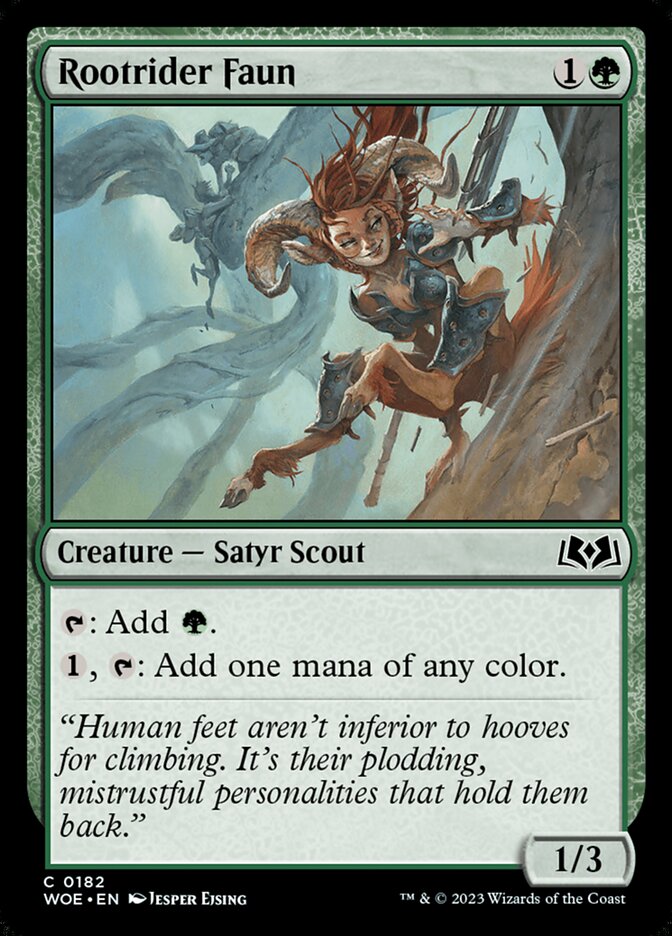
Rootrider Faun: Druid of the Cowl that splashes was good, like I imagined it would be, though it ended up as #4 rather than #1. Best in bigger green decks.

Redtooth Genealogist: Curve outs with this card are pretty solid, though it does suffer if you can’t stick a 2-drop for it. Best in Selesnya roles.
My score: 3/5
Curse of the Werefox and Return from the Wilds have both been good too, so I felt like green was the color I did the best job of predicting.
Recapping Commons to Avoid
In my last article, I called out these cards as ones to avoid:
- Slumbering Keepguard
- Freeze in Place
- Misleading Motes
- Warehouse Tabby
- Bespoke Battlegarb
- Harried Spearguard
- Bestial Bloodline
- Toadstool Admirer
I’d say I got about 6.5/8 of these correct. The main brick was Harried Spearguard, which has been a strong card in both Boros and Rakdos aggro decks. Bespoke Battlegarb is my “0.5”, as it’s bad in most decks but impressive if you have enough Ratcatcher Trainees and Gingerbrutes. The rest range from horrible (Freeze in Place, Toadstool Admirer, Bestial Bloodline) to weak filler.
2-Color Draft Archetypes
Below, I’ll cover the set’s standard 10 2-color archetypes in fair detail. I’ve ordered these 2-color pairs by how good I think they are below:
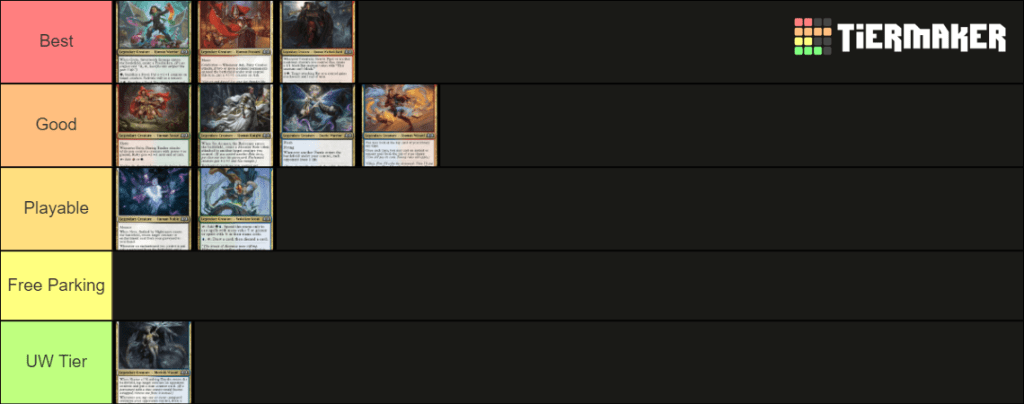
You should enter into drafts with a bias towards the big three, but be generally open to drafting anything that isn’t Azorius .
Golgari Food
The best deck in the format is a midrange deck based around some amount of Food synergies. You don’t really need anything fancy for success with Golgari , as it’s a classic good-stuff deck of removal + curve filler + fatties. This set doesn’t have a ton of fliers in it, which is another plus for this deck. Expect to play 17 lands in most builds (trimming a land might be fine if you have multiple Brave the Wilds).
Payoffs
Greta, Sweettooth Scourge is great on its own and has an incredibly high ceiling with other Food cards. Gingerbread Hunter, Tough Cookie, and Welcome to Sweettooth are premium uncommons as well.
Top Commons
If you have Food payoffs, cards like Feed the Cauldron, Hollow Scavenger, Mintstrosity, and Sweettooth Witch are ideal. Food tokens make it a great home for bargain spells like Brave the Wilds and Hamlet Glutton.
Trophy Example
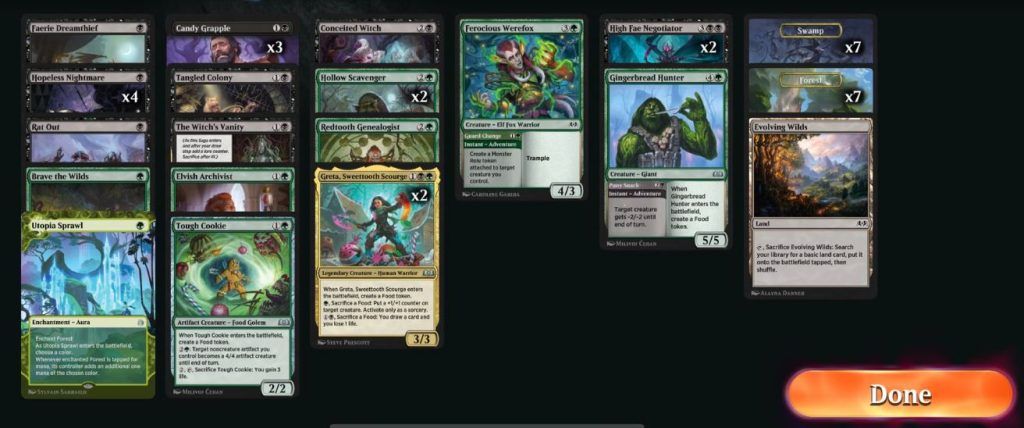
Trophy deck in Wilds of Eldraine by @DavidRoyale14
Playing Against It
Rx decks will usually need to go under Golgari . Save your Cooped Up and Moment of Valor for Hamlet Glutton if you can, but don’t be sparring with other removal spells. Golgari is the aggressor against most Ux control strategies, which have countermagic and stronger card draw spells. If you want to play a long game against Golgari , you must be aware of Sweettooth Witch’s damage potential (even if it’s not on board yet). Each Food your opponent has may suddenly turn into 2 damage late game. Plan on either countering or killing the Witch to keep your life total high.
Boros Aggro
Long-term readers of mine should know by now that I hate Boros , so take it as a high honor that I recommend this deck! Boros is seriously good in this format, and it can be a real threat with just commons. Expect to play 15-17 lands in most builds.
Payoffs
Boros doesn’t require higher-rarity cards, but Ash, Party Crasher, Imodane's Recruiter, Belligerent of the Ball, and Goddric, Cloaked Reveler are top-notch. Ash, Party Crasher in particular can be an obvious signal that you should be drafting !
Top Commons
The key to Boros’s success is redundancy; it curves out just fine with a number of playable creatures at each slot:
- 1 mana: (Harried Spearguard, Gingerbrute)
- 2 mana: (Grand Ball Guest, Ratcatcher Trainee, Hopeful Vigil, Armory Mice, Frostbridge Guard)
- 3 mana: (Stockpiling Celebrant, Minecart Daredevil, Redcap Thief
- 4 mana: (Edgewall Pack, Merry Bards)
Because of this, you’ll want to take premium removal like Torch the Tower and Cooped Up over common creatures (at least at first). After that though, focus on building a good curve above all else. And don’t forget that cards like Edgewall Pack and Merry Bards will always trigger celebration!
Trophy Example
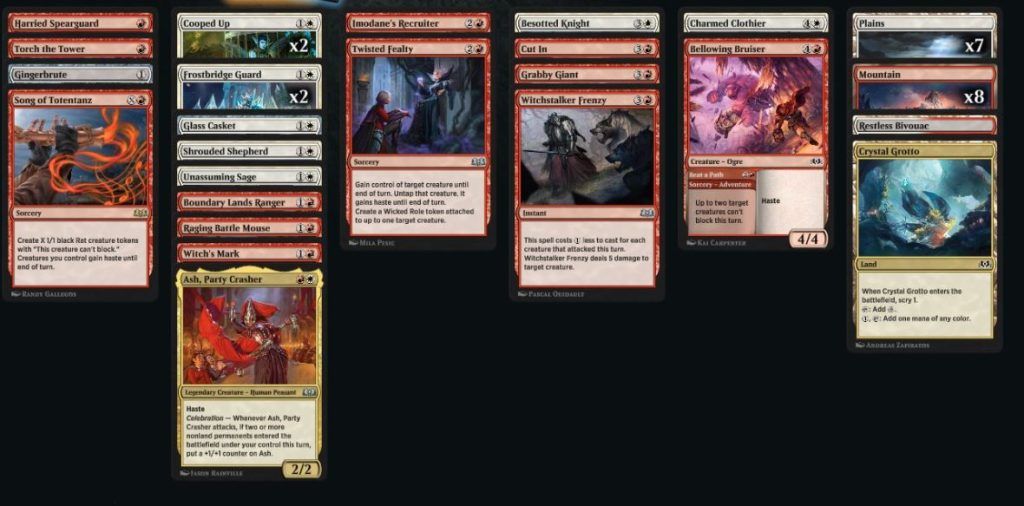
Trophy deck in Wilds of Eldraine by @MarcopicciM
Playing Against It
Getting on board quickly and having cheap removal is key, but you’ll still want to be careful in the midgame (even when the coast seems clear). Imodane's Recruiter is probably the scariest card you can see from Boros . If you want to be paranoid with leaving blockers back, consider playing around creature + Imodane's Recruiter mid game (+1/+0 to all attackers and two more boosted attackers).
Rakdos Rats
Rakdos is a tad slower than Boros , but it’s more resilient to removal. This deck can create very wide board states that give decks like Simic serious trouble. Expect to play 16-17 lands in most builds.
Payoffs
Totentanz, Swarm Piper is a solid signpost creature that excels on gummed up board states (which it can also create via trading sometimes). Rakdos also has a number of very powerful rares that play off its theme (Redcap Gutter-Dweller, Song of Totentanz, and Lord Skitter, Sewer King).
One unique thing about Rakdos is that it gets more value out of the Enchanting Tales bonus sheet than most decks. Goblin Bombardment is nuts here, but I’ve also seen players have some success with Vampiric Rites, Shared Animosity, and Raid Bombardment as well. How much you should care about these kinds of effects will always come down to the number of rat cards you have.
Top Commons
Ratcatcher Trainee, Voracious Vermin, and Edgewall Pack are the best commons for 2/3/4 in this archetype. Gnawing Crescendo isn’t a priority, but I like a copy in most decks. Rat Out and Harried Spearguard have been solid too. Basically, your common pick order should be premium removal > premium creatures > everything else.
Trophy Example
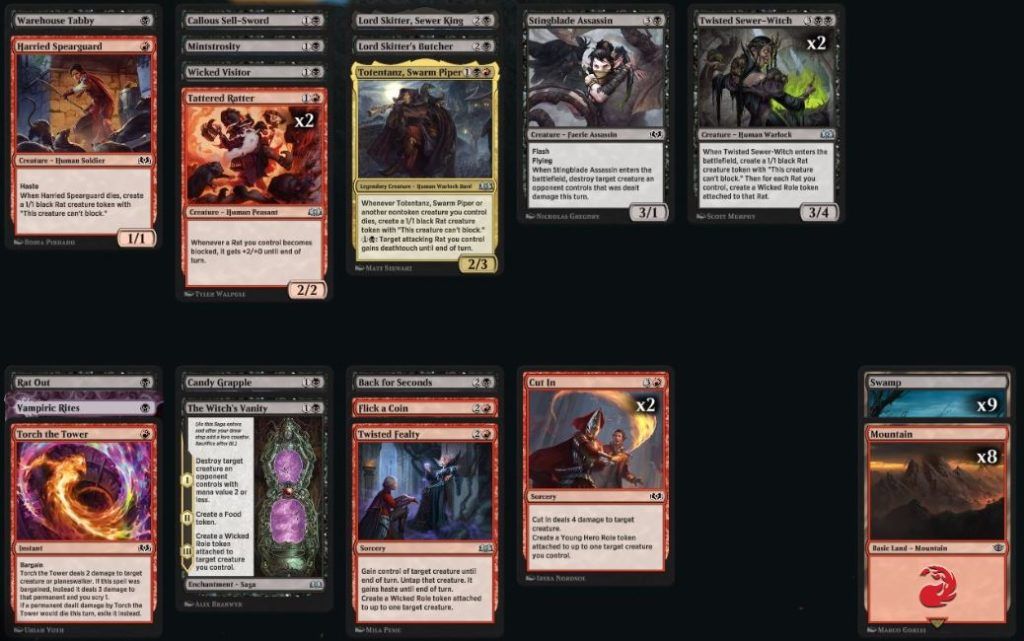
Trophy deck in Wilds of Eldraine by @xapablancaGG
Playing Against It
Don’t fa l behind early if you can help it, as Rakdos tends to go wider than most decks can handle. Having a high life total will help discourage your opponent from swinging out. If you’re racing Rakdos , Gnawing Crescendo and Twisted Fealty are great cards to be aware of. X/1 hate, like Rat Out, Flick a Coin, and Shrouded Shepherd is definitely at its best against .
Gruul Monsters
Gruul is a straightforward archetype that sits on the midrangey side of aggro decks. There aren’t actually many payoffs for its 4/x theme, so focus on curving out and punching faces. Expect to play 17 lands in most builds.
Payoffs
Ruby, Daring Tracker is the best reason in the set to care about 4/x creatures, as having support upgrades Ruby from a harmless dork to a real beater. Picnic Ruiner is also great at any point in the game. Two-Headed Hunter is a good red card in general that also has the highest cheese potential in Gruul thanks to all the high-power creatures. Garruk's Uprising also deserves a nod as a payoff for going deep on 4/x creatures.
Top Commons
Ferocious Werefox is the best of the 4/x common creatures. If you want more, Bellowing Bruiser, Grabby Giant, Minecart Daredevil, and Verdant Outrider are all playable. Try to build a good curve and prioritize the best commons I covered above.
Trophy Example

Trophy deck in Wilds of Eldraine by @DieselHS112
Playing Against It
Removal is the most important thing against Gruul, particularly broad removal that hits large creatures. There is no matchup in the format that's better for Moment of Valor than this one. If Gruul stumbles, don’t be afraid to try to race them, as the deck struggles once it falls behind.
Selesnya Roles
Selesnya is another archetype that sits somewhere between aggro/midrange. It’s the most enchantment-focused color pair in the set. Pace-wise, Selesnya can be awkward, as it’s not as fast as other aggro decks and leans hard on certain (killable) uncommons to generate value. Expect to play 16-17 lands in most builds.
Payoffs
Syr Armont, the Redeemer is a great creature that effectively has 6/6 worth of stats for 5 mana. Tanglespan Lookout almost feels like Selesnya’s “real” signpost though, as no color pair can expect to draw more cards off it than Selesnya does. This is a strong signal to consider drafting it if it goes late enough. Redtooth Vanguard also plays better here than in most other archetypes, but I still wouldn’t take it over Hopeful Vigil.
As for higher rarity payoffs, Elvish Archivist, Yenna, Redtooth Regent, Spellbook Vendor, and Archon of the Wild Rose all excel here. Yenna, Redtooth Regent even has a sweet combo with Three Blind Mice) if you get lucky enough!
Top Commons
Efficient role creatures excel in Selesnya , so prioritize Ferocious Werefox and Redtooth Genealogist higher than normal. Other role creatures like Unassuming Sage, Besotted Knight, and Charmed Clothier are fine too. Curse of the Werefox and Cooped Up are two other cards that play better in this archetype than most others.
Trophy Example
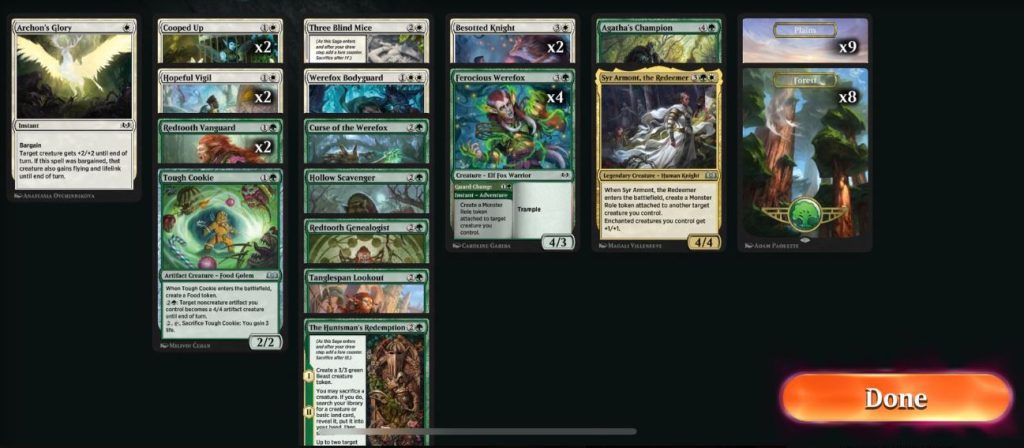
Trophy deck in Wilds of Eldraine by @DavidRoyale14
Playing Against It
Selesnya is a pretty typical Limited deck that you’ll want to go under/over depending on your strategy. Disenchant effects like Stormkeld Vanguard are better against it than most other decks. And don’t forget about Royal roles; ward (1) is innocuous, but it can ruin your removal plans if you aren’t careful.
Dimir Faeries
Faeries is a classic tempo strategy that harkens back to the days of Lorwyn. Annoying cheap fliers can peck away at your opponent while removal/countermagic keeps them honest. Expect to play 17 lands in most builds.
Payoffs
Dimir Faeries has quite a few solid payoffs in this set. Obyra, Dreaming Duelist is an obvious one, but beyond that, you also have Picklock Prankster, Faerie Fencing, Ego Drain, and Talion's Messenger. Most Faerie payoffs are passable on their own but become great with 8+ Faeries.
Top Commons
Spell Stutter is a clear winner in Dimir Faeries, and a key card for the archetype. Barrow Naughty is also great here and mediocre elsewhere. The ideal balance for most faerie decks is a cheap curve with a lot of interaction and two copies of Into the Fae Court at the top of your curve. Trade early and often, rebuild later, and aim to win with incremental damage.
Trophy Example
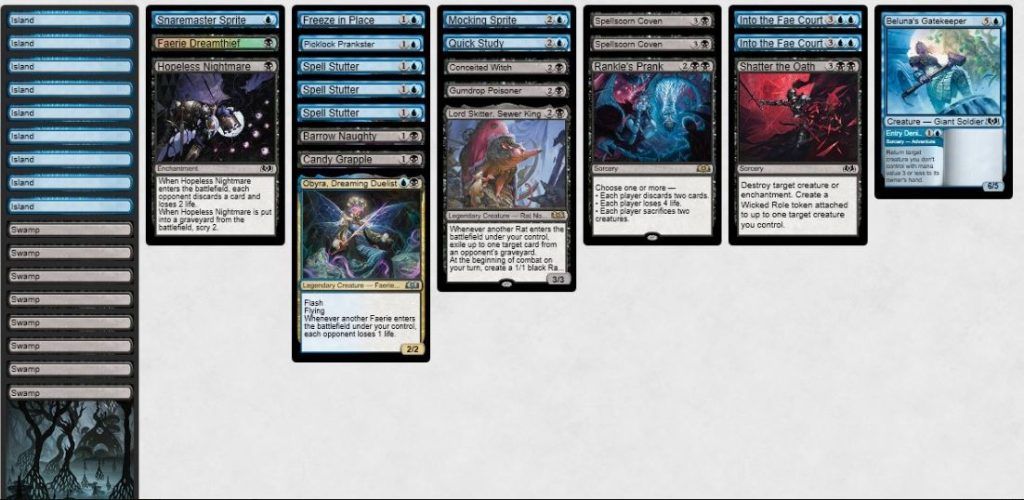
Trophy deck in Wilds of Eldraine by @DavidRoyale14
Playing Against It
Aggro decks have a better matchup against Dimir than most other strategies, as they play better against countermagic and can usually race it. If you're a slower deck, your best tools will be reach creatures, removal spells, and card draw. A critical mass of good stuff is important because you can’t expect to resolve everything against Dimir . Try to play around Spell Stutter if possible, either by saving your best spell(s) for last or setting up spots where you can pay the 2+X tax.
Orzhov Midrange
Orzhov is one of the more grindy decks in the format. You’ll often play long games with this archetype and win with incremental board/card advantage. Expect to play 17 lands in most builds.
Payoffs
Neva, Stalked by Nightmares is a strong value creature and a great draw to this archetype. Of particular note is its “whenever an enchantment you control is put into a graveyard,” clause. Orzhov is the best color pair to take advantage of this line of text on this/similar cards. Knight of Doves and Ashiok's Reaper are other uncommon payoffs with this text, though both require particular decks to succeed.
Top Commons
Hopeless Nightmare and Hopeful Vigil are BW’s all-star commons, and should be taken over anything not named Candy Grapple. Stockpiling Celebrant is an excellent card here too. Orzhov does a great job at leveraging bargain spells, including lesser played ones like Rowan's Grim Search.
Trophy Example

Trophy deck in Wilds of Eldraine by @mattvaessen
Playing Against It
Going over the top of Orzhov is possible, but it usually depends on them running out of answers to bombs or Hamlet Glutton. Most decks will probably be the aggressor against it. If you have countermagic, hitting its 2-for-1s and Stockpiling Celebrant can be a solid gameplan.
Izzet Spells
Izzet Spells is a classic archetype that feels more controlling in Wilds of Eldraine than it usually is. Izzet often finds itself sitting behind Unruly Catapult and Johann, Apprentice Sorcerer in order to build up incremental advantage. Expect to play 16-17 lands, as cantrips like Sleight of Hand will occasionally let you trim a land.
Payoffs
Johann, Apprentice Sorcerer is one of the strongest signposts in the set. A key aspect to the card is that you can cast adventures off it, but you’ll be limited to just the instant/sorcery mode. Frolicking Familiar, Gadwick's First Duel, and Tenacious Tomeseeker are other adjacent payoffs.
Top Commons
Frantic Firebolt, Unruly Catapult, and Aquatic Alchemist are all Izzet-specific commons that excel in this archetype. I wouldn’t prioritize any of them over Torch the Tower, though. All three of the Treasure-makers (Flick a Coin, Redcap Thief, and Grabby Giant) are also great and can enable splashes like Candy Grapple or Agatha's Champion.
Trophy Example
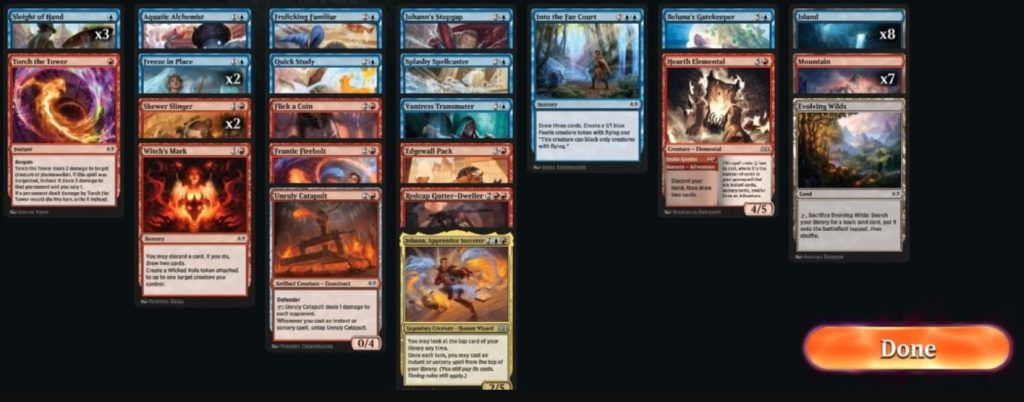
Trophy deck in Wilds of Eldraine by @MarcopicciM
Playing Against It
Izzet won’t usually have sweepers, so getting ahead early is important. If you aren’t that aggressive, it's important to save your removal for card advantage generators like Johann, Apprentice Sorcerer. Izzet’s removal is mostly damage-based, so you can blow it out with combat tricks like Archon's Glory and Leaping Ambush
Simic Ramp
This sluggish ramp strategy is generally outclassed by Golgari , which has a better signpost card and much better removal. It’s not all bad news for Simic though, as it can be a great base for a greedy 4- to 5-color deck. Expect to play 17-18 lands depending on your build (Simic is the most mana-hungry color pair in the format).
Payoffs
Troyan, Gutsy Explorer is a decent creature that shows off Simic’s focus on 5+ mana value spells. The mana mode is limited, but looting makes up for that. Up the Beanstalk is an even better payoff than Troyan, but it’s also just plain good in most decks. The “5 or more” theme is otherwise pretty restrictive with just Tempest Hart and Galvanic Giant as additional payoffs.
Top Commons
Hamlet Glutton, Rootrider Faun and Return from the Wilds should be your highest priorities. Beanstalk Wurm has overperformed in Simic as a 5-cost spell that doubles as another ramp spell. Prophetic Prism and Brave the Wilds are other cards I like to prioritize, as Simic splashes more than any other archetype.
Trophy Example
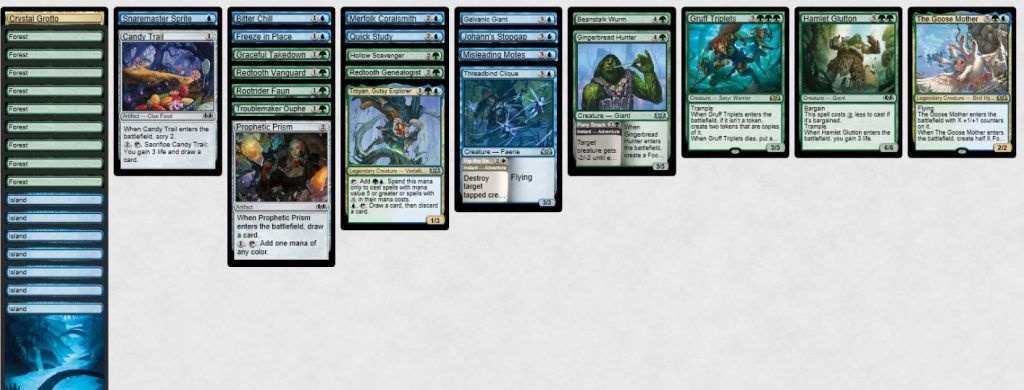
Trophy deck in Wilds of Eldraine by @MarcopicciM
Playing Against It
You're usually going to be the aggressor against GU, as it’s almost always a ramp/control deck of sorts. Red decks will want to get on board fast and “bolt the bird” when they can. Blue decks should try to save Spell Stutter and Ice Out for 5+ cost cards. Pay close attention to your opponent’s cards/colors, and be careful of surprise blowouts from splashed removal like Candy Grapple coming off of a Rootrider Faun or Prophetic Prism.
Azorius Frost
We have finally arrived at the set’s only truly bad archetype. So why am I being so harsh on Azorius?
Well, it pretty much comes down to a number of things:
- Azorius depends heavily on a handful of higher-rarity payoffs.
- These payoffs, in turn, depend on bad commons to work. Getting a critical mass of tapping effects often requires slumming it with bad commons.
- Even if you have both, the tap theme can fail if your opponent is winning the race (due to caring about the creature being “untapped”). I’ve heard tales of Icewrought Sentry being raced this way.
- Azorius’s tap theme is also rather isolated; it doesn’t have any overlap with celebration, bargain, Food, or any of the set’s other themes.
Anyways, it’s not the end of the world. You can win with this archetype, and I know this because I lost one of my Day 2 Arena Open matches to it. My lucky opponent curved Icewrought Sentry into Solitary Sanctuary both games and even had Water Wings…erm, what was I saying again? You should expect to play 17 lands in most builds.
Payoffs
Azorius’s payoffs are the best thing about it. UWx players win 60% of the games they draw it in, but win only 49% of the time when they don’t! Its four payoffs (Icewrought Sentry, Hylda's Crown of Winter, Hylda of the Icy Crown, and Solitary Sanctuary) stack well together, and only Solitary Sanctuary is bad on its own. Succumb to the Cold is a powerful enabler that no one else should be prioritizing.
Top Commons
Azorius’s biggest problem is a lack of strong commons to force its theme consistently. There are no common reasons to care about tapping. If you want to use commons to do the tapping, your options are Frostbridge Guard, Plunge into Winter, Rimefur Reindeer, Freeze in Place, Snaremaster Sprite, and Vantress Transmuter (the tap is subtle but appreciated).
Of these, I’d say that Frostbridge Guard, Plunge into Winter, and Vantress Transmuter are the most practical. Friends don’t let friends play Freeze in Place, even in this archetype.
If you aren’t doing the tap theme, there really isn’t much reason to be playing Azorius . It has the lowest general card quality of any color pair. Just play Simic or Selesnya instead and splash whatever cards have you eyeing Azorius .
Trophy Example

Trophy deck in Wilds of Eldraine by @xapablancaGG
Playing Against It
Aggro decks should attack early and often, as keeping your creatures tapped will prevent Azorius’s cards from functioning correctly. Regardless of your archetype, though, success against Azorius is often determined by whether or not Icewrought Sentry, Hylda of the Icy Crown, or Sharae of Numbing Depths dies. Removal is important, and hard removal like Candy Grapple and Shatter the Oath does the best.
Other Things You Can Do in Wilds of Eldraine
Outside of the big 10, there are a couple of things you can try.
5-Color Control
This deck will usually be GBx or GUx, though by “5-color” I mean more than just “GU + Gingerbread Hunter”. Either way, this format really does have the level of fixing required to support a deck like this. Getting into 5-color happens when you're Gx, staying open, and highly prioritizing fixing. There are no explicit payoffs or anything, but the multitude of powerful adventures in the set can make greed rewarding.
Treason + Sac
It’s not easy in this set, but Twisted Fealty and Eriette's Tempting Apple can pull off a common Rakdos line. Your main combo pieces are going to be Callous Sell-Sword and Lord Skitter's Butcher. You can only use bargain spells if you're gaining control of a token creature. This is usually just a subtheme in Rakdos Rats, rather than a whole archetype.
Splashing in Anything
This includes aggro decks. I had a great time playing Ingenious Prodigy in my lean 2x Ash, Party Crasher aggro deck, as I was already leaning on Redcap Thief to trigger celebration. With just 3+ sources of your off-color, you’re free to play all sorts of powerful one-pip cards.
Sideboarding
This doesn’t apply to BO1 gamers on Arena, but in BO3 Magic, you have a lot of options for sideboarding in this set. Here are some examples of sideboard play patterns to look out for:
- Spider Food versus fliers, Cooped Up, or broken rares like Virtue of Loyalty. Break the Spell solves similar problems.
- Moment of Valor in against Gruul monsters/specific rares like Archon of the Wild Rose, out against your average aggro or faeries deck.
- Adding more removal/cheap creatures against aggro, particularly on the draw.
- Boarding in/out more copies of Rat Out based on how many x/1s your opponent has.
- Boarding in/out cards like Vantress Transmuter, Misleading Motes, and Ice Out based on matchup (obviously best against Hamlet Glutton decks, and worst against Boros /Rats).
- Trying to mise opponents with combat tricks they haven’t seen yet (i.e., “I think they will block into Sugar Rush, they blocked every other game”), or boarding out the ones they have seen.
- Boarding out Fell Horseman and Back for Seconds against fast decks with unfavorable removal for them (Torch the Tower, Cooped Up).
- Siding in more greedy cards like Collector's Vault, Into the Fae Court, and Moonshaker Cavalry in anticipation of longer games.
Wrap Up

Flick a Coin | Illustration by Andreia Ugrai
And that should do it! Hopefully I gave you enough information for success in your drafts going forward. This has certainly been a diverse draft format, and I wish you the best of luck at your next FNM or Arena Open!
If you have any questions about this article/format, feel free to comment here or message me on Twitter. Let me know all about your draft experiences and crazy builds in the comments below!
Thanks, and until next time, may you open many Gruff Triplets!
Follow Draftsim for awesome articles and set updates: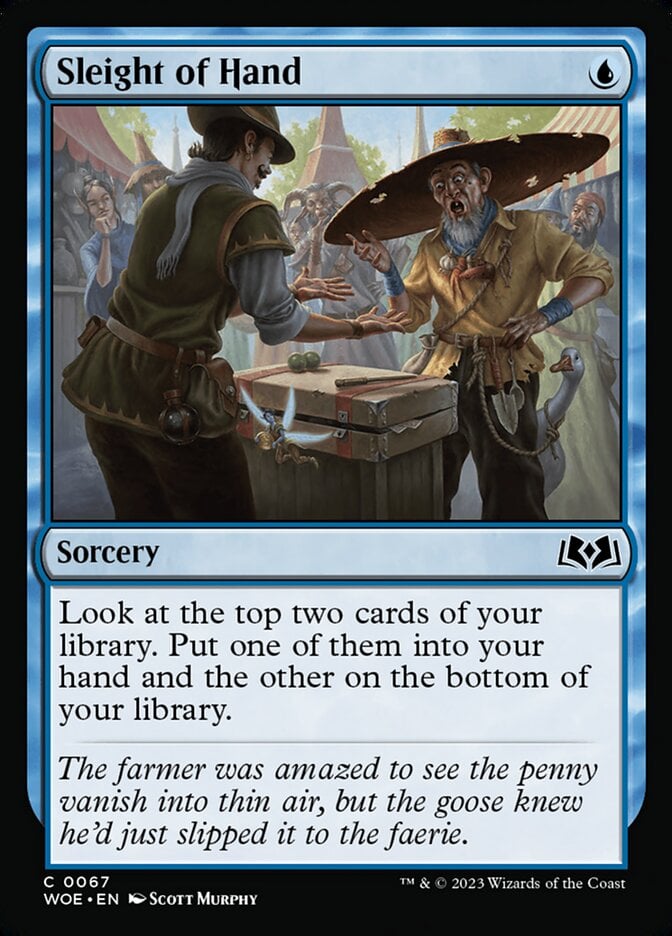

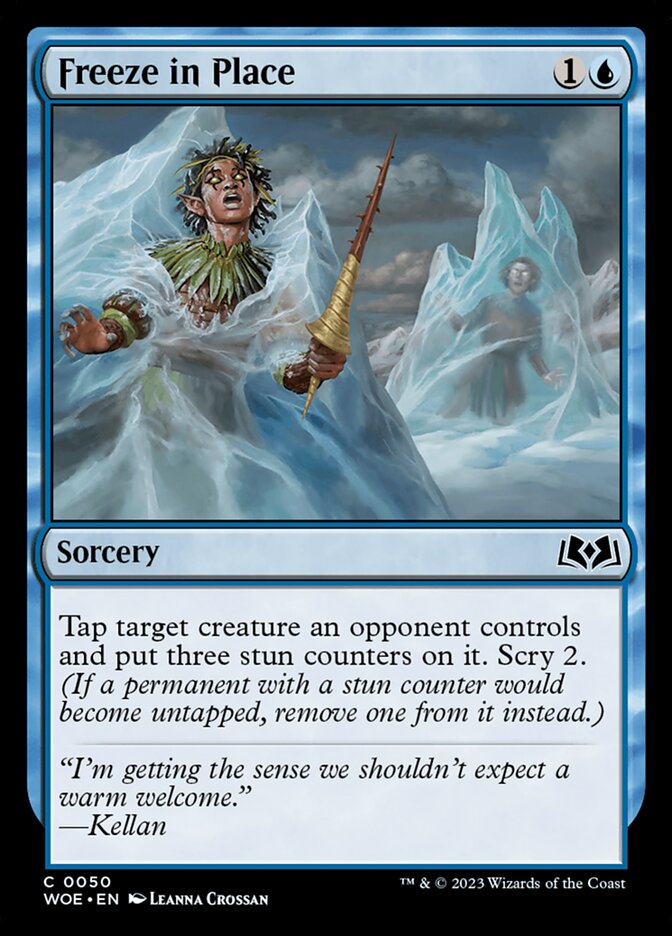
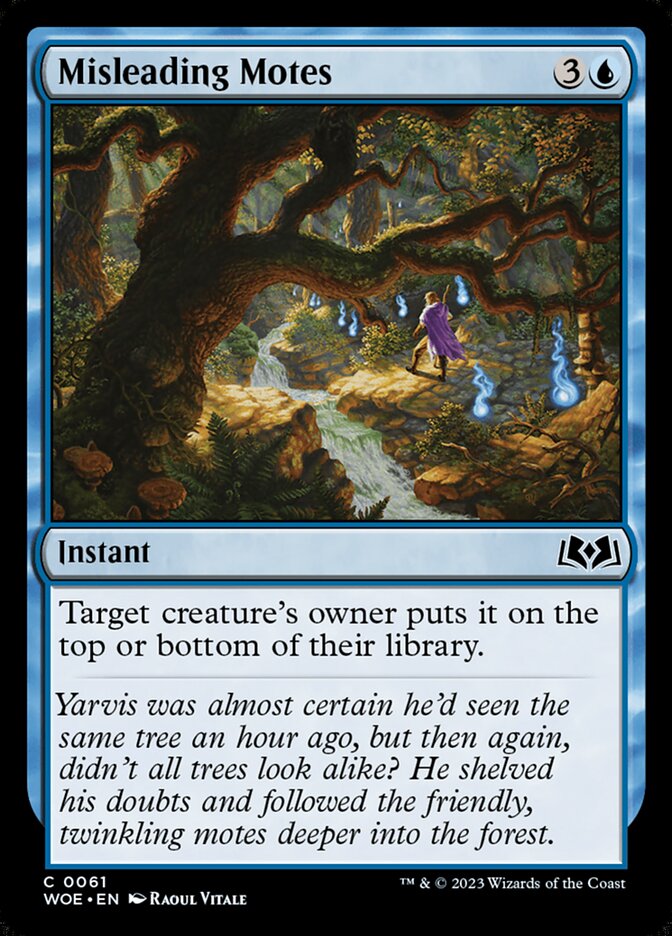
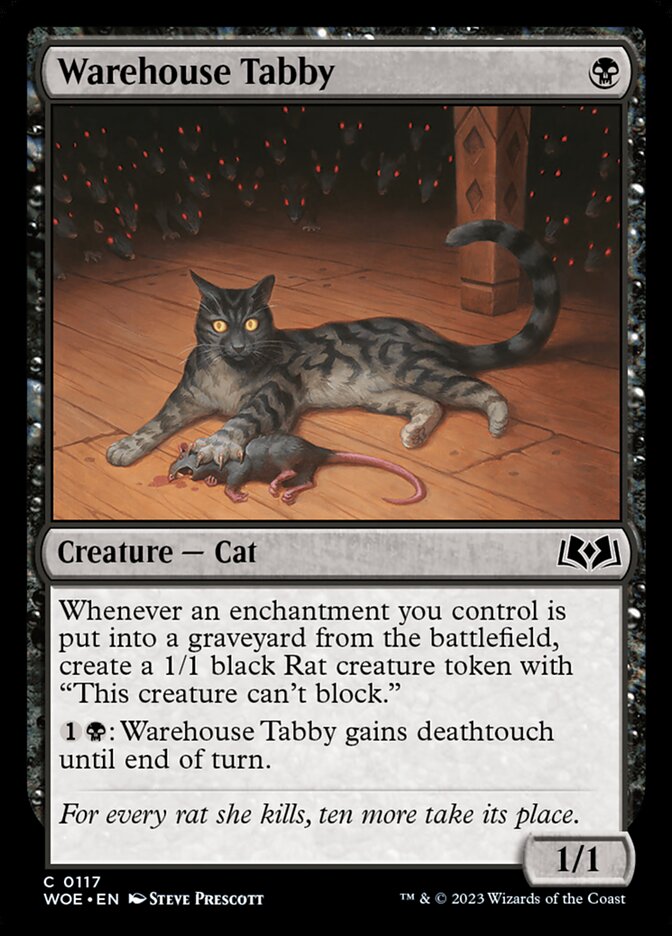


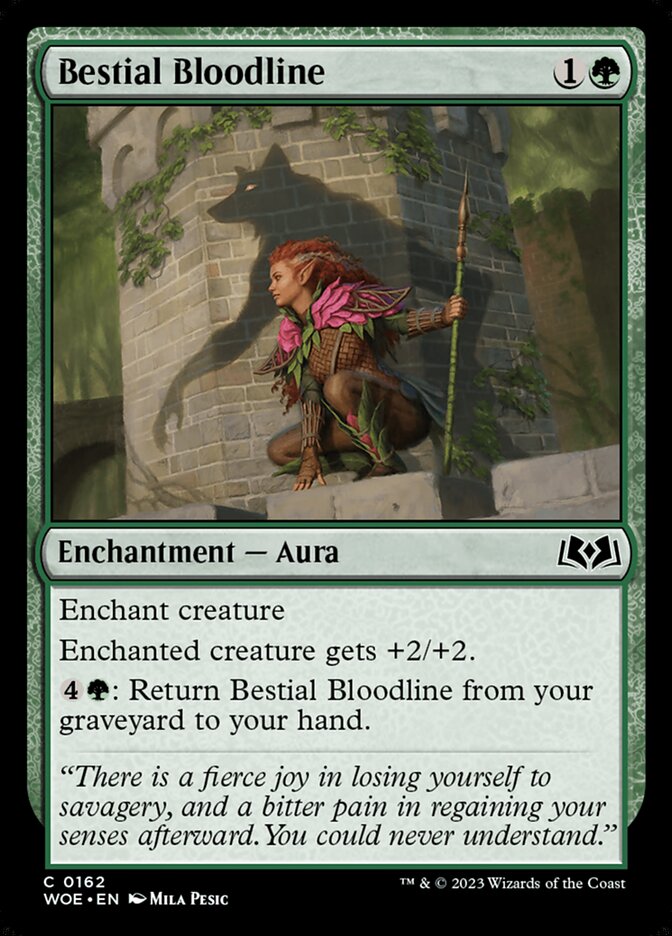
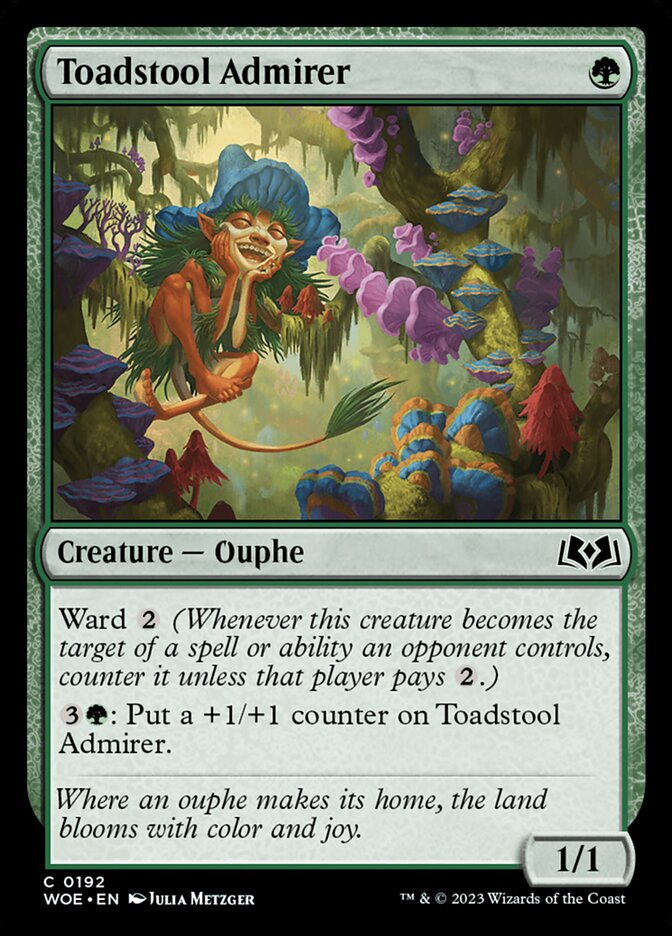
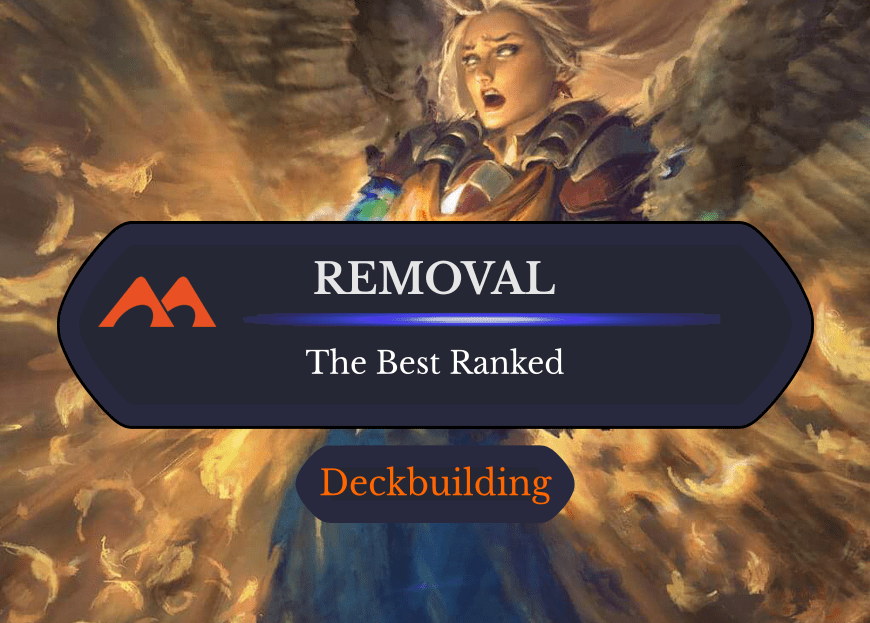
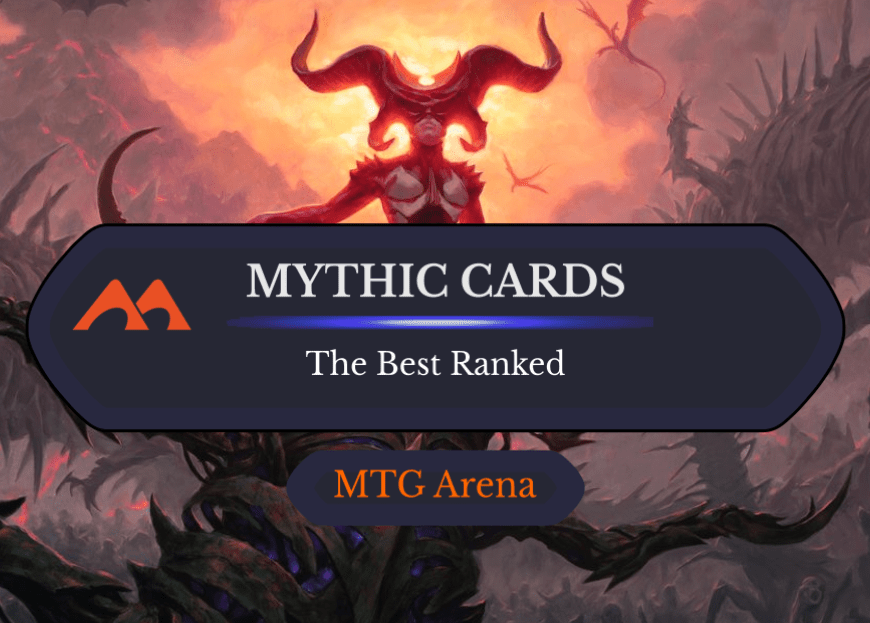
1 Comment
Great article man! I took the last 6 months off magic and went Boros and trophied first try. Thanks for the great tips!
Add Comment